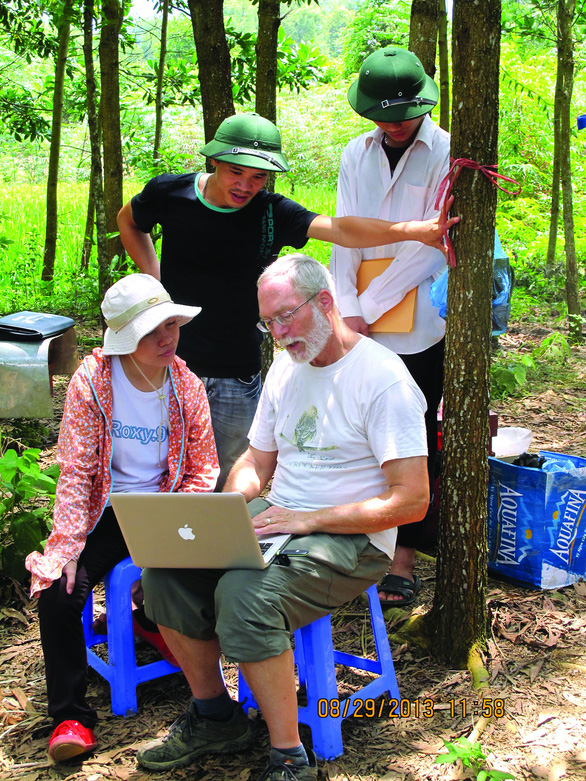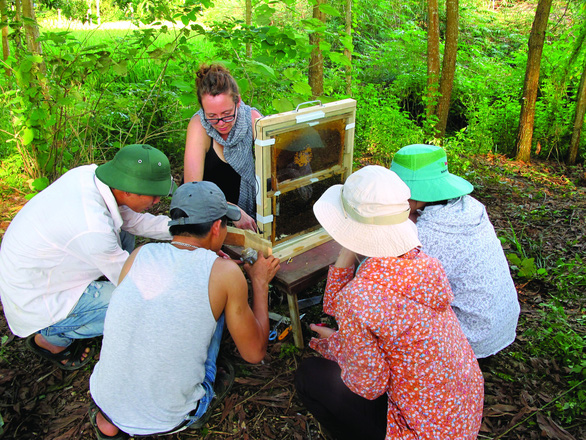For nearly three decades, Canadian entomologist Gard Otis has dedicated himself to the study of behavior patterns in a native Vietnamese honeybee species, as well as to the development of local bee farming talent and technology in the north-central province of Ha Tinh.
Otis spent 36 years as a professor at the University of Guelph, Ontario, Canada, where he specialized in honeybee biology and behavior, insect ecology, and forest entomology.
The distinguished researcher currently serves as an adjunct professor at the university’s School of Environmental Sciences.
A key area of Otis’s research and interest is focused on ‘murder hornets,’ commonly known as Asian giant hornets (Vespa mandarinia).
While working on National Geographic Society-funded beekeeping projects in north-central Vietnam several years ago, Prof. Otis began conducting extensive research on Vespa soror, a sister species to Vespa mandarinia.
Both hornets share similarities in size and behavior, including their tendency to attack and even ‘slaughter’ honeybee colonies.
In a video call with Tuoi Tre (Youth) newspaper in late January, the professor proudly shared the results of a recent study he undertook with the help of associates in Vietnam and the U.S., during which he discovered a collective defense strategy adopted by honeybees (Apis cerana) against swarms of Vespa soror.
The article was published late last year in PLOS ONE, a peer-reviewed journal launched by PLOS -- a nonprofit, Open Access publisher which empowers researchers to accelerate progress in science and medicine.
According to the article, honeybees in Asia have evolved under predatory pressure from social wasps in the genus Vespa, the most formidable of which are the giant hornets that attack colonies in groups, kill adult defenders, and prey on broods.
The team’s documentation revealed for the first time that, in response to attacks by V. soror, which frequently land on their way into nests, A. cerana workers foraged for and applied animal feces to their nest entrances.
|
|
| ‘Murder hornets’ slaughter a colony of honeybees in Japan. Photo: Getty Images |
Fecal spotting intensified after colonies were exposed either to naturally occurring attacks or to chemicals that scout hornets employed to zero in on colonies for mass attacks. Spotting persisted for days despite the cessation of attacks, the study showed.
Moderate to heavy fecal spotting stamped out attempts by V. soror to penetrate nests by reducing the incidence of multiple-hornet attacks and significantly lessening the likelihood of the ferocious wasps approaching and chewing nest entrances.
These findings are the first official report of honeybees using tools to repel aggressive predators, as well as the first published evidence of insects foraging for non-plant-based solids from livestock and poultry.
The study also includes an in-depth description of the sophisticated portfolio of defenses that honeybees have developed to cope with the constant predatory threats they face, including physically shielding the colony from predators by building enclosed walls and closely guarded small entrances; synchronized body shaking or wave-like visual displays; and producing hissing or buzzing sounds in response to predators.
Another effective defense employed by honeybees involves killing hornets by overheating and suffocating individual attackers in a ball of bees.
While it remains a puzzle as to how animal dung repels hornets, the research team found that honeybees use a variety of smelly filth to repel aggressors, including human urine and soap.
“We’re not in favor of animal feces being applied as textured spots on the fronts of hives, as no one would want to consume honey from such hives,” Prof. Otis noted.
“The key is likely the odor itself, not a particular substance.”
Though much remains to be understood about this predator-prey interaction and repellency mechanism, the groundbreaking study suggests that bee farmers can apply substances with a strong, long-lasting odor, such as clove oil, around hive entrances to keep predatory hornets at bay.
A bond with buzzers in Vietnam
Prof. Otis’s enduring interest in the defensive behavior of Asian honeybees began more than a decade ago when he initiated a beekeeping development project in several rural communes in north-central Vietnam’s Ha Tinh Province.
Managed by the Association of Universities and Colleges of Canada, faculties from several Canadian universities worked with colleagues from the Vietnam Bee Research and Development Center to devise and execute the extensive research and training project.
|
|
| A research team from Canadian Professor Gard Otis's project work during a field trip to Ba Vi District in suburban Hanoi, Vietnam in 2013 in this supplied photo. |
During his time working on the project, Otis was stumped by the black spots which covered local honeybee nests. Locals seemed equally puzzled and only knew that the spots typically appeared following hornet attacks.
Only one seasoned beekeeper who had witnessed the insects’ defensive behavior first-hand was able to offer up an answer: “It’s buffalo dung.”
In 2012, Prof. Otis persuaded his former student, Heather Mattila, an associate professor of biology at Wellesley College in Massachusetts, the U.S., to join him in his research on the honeybees’ ‘feces applying’ behavior.
The duo also managed to enlist help from two Hanoi-based experts – Dr. Pham Duc Hanh from the National Institute of Animal Sciences of Vietnam and Dr. Nguyen Thi Phuong Lien from the Institute of Ecology and Biological Resources.
“It turned out the four disciplines we major in allowed us to make our research a success in 2013,” Prof. Otis said, adding the data analysis took six years.
Mattila, the study’s head, shared in an email to Tuoi Tre that both Prof. Otis and herself considered their research experience in Vietnam a highlight of their academic careers.
Each passing day during the research period was unforgettable, she stressed, adding that she hoped to one day work with an equally wonderful and diverse team.
To prove the honeybees’ unique defensive behavior, the scientists needed ‘invincible’ hives in a controlled experiment with attacked nests.
The team used a white balloon tied to a stick held by research assistants to drive the hornets away.
To make sure they always had enough feces at their disposal for the honeybees to take their pick, they built a small ‘feces shop’ with solids from poultry and cattle, Prof. Otis shared.
By the end of the day, around 140 honeybees would drop by the ‘shop’ before buzzing off with a morsel of dung in their mouth.
“The interesting thing is we were actually at a loss what to look for and observe at first. We just had to learn about the honeybees’ behavior little by little each day,” shared Phan Thanh Ngoc, a member of Prof. Otis’s research team.
Later, with Otis’s mentoring and assistance, Ngoc was able to skip earning his master’s and move directly on to earning a Ph.D. in entomology at the University of Pennsylvania in the U.S.
A buzz around beekeeping
Dr. Ngoc is not Otis’s only mentee.
Back in 1996, Prof. Otis attended a conference organized by the Asian Apiculture Association in Vietnam.
By the end of the trip, he had made a commitment to seek funding for a project to foster the development of bee farming in the Southeast Asian country.
The pundit was particularly impressed with researchers from the Vietnam Bee Research and Development Center (VBRDC), who tried to answer his thorny questions with complete honesty.
“That was when I decided to get them involved,” he said.
To prepare for his project, Prof. Otis took a trip across Vietnam to collect samples of the country’s honeybee species.
After 10 years, he managed to earn sponsorship from the Canadian International Development Agency in order to provide training in beekeeping techniques for more than 190 households in six communes in Huong Son and Vu Quang Districts in Ha Tinh between 2007 and 2012.
Exceeding the project developer’s expectations, the trainees were able to maintain bee farming businesses well before the project’s end and were even able to share techniques with bee farming newcomers.
“We knew we had to get the people working with the bees and doing things with the bees. Everything fits together in a system that’s integrated with the seasonality,” he shared in a video clip posted on the University of Guelph’s website in 2012.
“These trainees have actually put it all together into a system that they’re able to innovate.
“The beekeeping technology is extending more quickly than I would imagine.
“Within a small area, they now have essentially all the components of a complete industry.
"I think it will allow them to be sustainable with this activity far into the future.”
Huong Son and Vu Quang Districts’ products have made their way on to the country’s honey map.
A first and foremost part of the project includes providing training for lecturers at VBRDC so that they can properly teach new students.
During this training, Otis met Hanh, a VBRDC researcher, who later became his Ph.D. student and a co-author in their latest study on honeybees' ‘feces applying’ defensive practice.
According to the professor, financing a Ph.D. student’s program spanning three or four years accounted for a big part of the project’s budget.
They need a well-trained scientist capable of raising valuable research questions and gaps, designing viable experiments, training younger generations and also fluent in English, he explained.
“With all of Vietnam’s indigenous bee species in sight, I’m like a kid in a candy store,” Prof. Otis shared, adding that there is only one species of honeybee in North America and it has lost its novelty among researchers.
The giant hornets habitually disappear around November each year to prepare for a new queen bee ‘empire’ before making their comeback in August the following year.
During that time, colonies of honeybees stop applying new fecal spots and old spots are washed away by natural elements.
Prof. Gard Otis felt sorry that no Vietnamese experts or farmers had seemed to question this abnormal phenomenon, which occurs for around two and a half to three months each year.
How honeybees use feces to defend colonies
Apis cerana defended their colonies from group attacks by Vespa soror by applying fecal spots around hive entrances.
- A hive front with heavy fecal spotting around the entrance opening
- A marked A. cerana forager on a dung pile
- A forager holds a clump of fecal solids in her mandibles.
- A forager applies a fecal spot to a hive front after being paint marked on a dung pile.
- An entrance-focused group attack on a colony of honeybees by V. soror workers
- Damage to a hive entrance after entrance margins were chewed on by V. soror workers, with the attack disrupted by experimenters before the hive was breached.
Vietnam’s Ministry of Agriculture and Rural Development conferred on Prof. Gard Otis the ‘Order in recognition of contributions to Vietnam’s agriculture and rural development’ in late 2014.
His dedication to the Southeast Asian country’s apiculture sector is also something personal.
Born in the U.S., Otis would have been conscripted for the American war in Vietnam, which ended in 1975.
When he first visited Vietnam, he was psychologically geared up for anger and unfriendly attitudes that he thought awaited him. To his great surprise, this never happened.
“There’s another reason that I want to work with Vietnamese people. You’re so kind and forgiving and even nominated me for a prize,” he shared, adding that he threw a party with those who had given him their full backing.
“I really love Vietnam, where many of my friends are.”
Like us on Facebook or follow us on Twitter to get the latest news about Vietnam!





















































